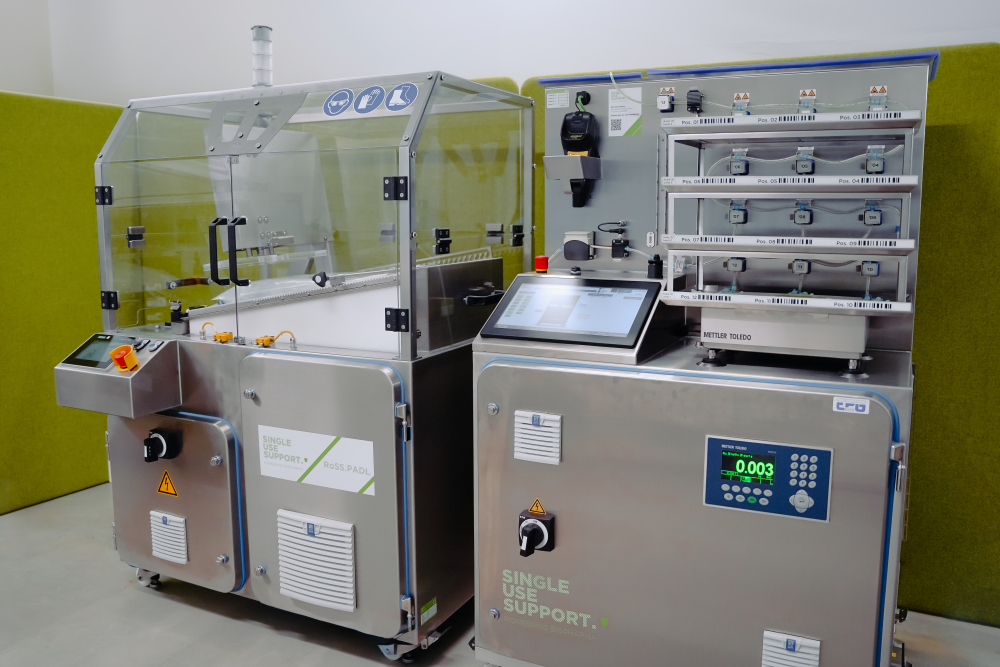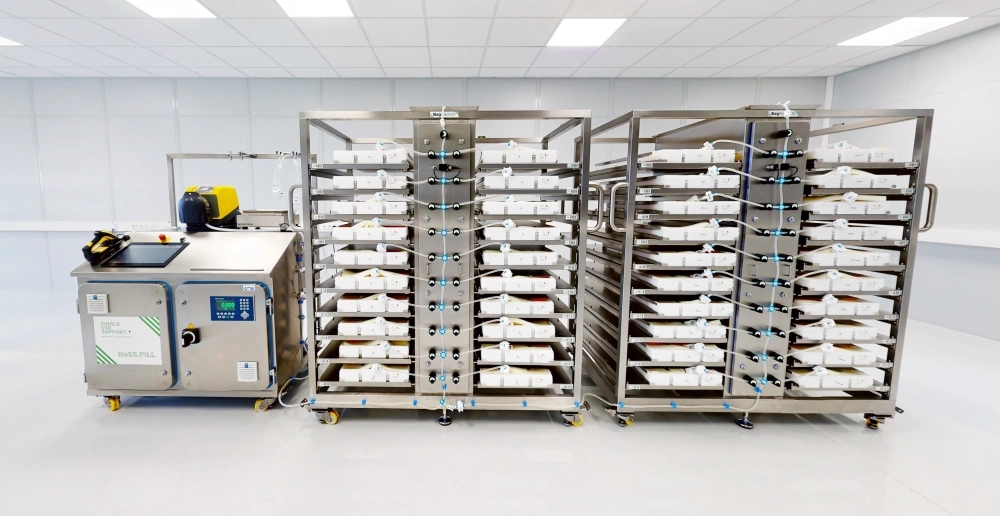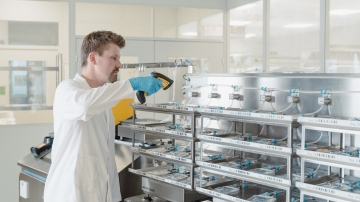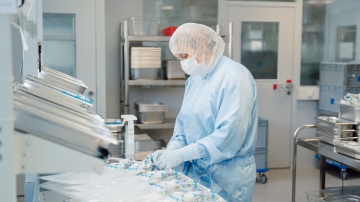Fluid management systems: 7 considerations to be made
Table of contents
ShowAutomated fluid management systems have gained a lot of popularity in the recent past. Production processes in biopharma have never been more competitive. New advances and research in gene and antibody therapy have called for more streamlined production steps.
An important factor is safe and efficient fluid handling, which is still often carried out manually. This does not only leave more space for human errors, it can also affect staff and patient safety. Automated fluid management systems, in combination with single-use technologies, help to reduce product loss and rid medical staff of monotonous and laborious tasks like pipetting.
However, as not every fluid management system is the same in terms of production yields and functions, there are several considerations to be taken into account. Here are seven questions you should ask to make the right choice.
1. What is a fluid management system and what is it good for?
A fluid management system (FMS) serves as an automated solution in the handling of sensitive fluids which have to be protected from contamination. FMS are used in different industries and have proven to be especially valuable for aseptic fluid management processes in biopharma production and therapeutic treatments.
The advanced technology automates different steps (or the complete process) of the workflow, which had to be carried out manually by healthcare professionals in the past. Different case studies have shown that automated systems are able to reduce the risk of human errors and, consequently, product loss.
Sterile connectors in automated aliquoting systems ensure that fluids are not exposed to any contaminating factors during filling into containers or fluid controls.1
Fluid management system from Single Use Support
Single Use Support provides advanced fluid management systems through automated end-to-end processes. The seamless homogenization and filling solutions, featuring single-use assemblies, adhere to the highest quality and efficiency standards within the biopharmaceutical industry. Explore the full range of our fluid management systems to elevate your pharmaceutical manufacturing processes.
Due to the specifics of each individual projects, the components needed for a liquid handling can vary. Whereas in antibody production for biopharmaceuticals, freezing and filtration is often part of the process due to transport or conservation purposes, this is seldom the case in diagnostics.
Let us start with a homogenization solution, like RoSS.PADL. This system is able to cool and homogenize substances simultaneously in single-use bags, allowing for optimal temperatures during draining. For aseptic filling in a closed system, the essential components include pumps, valves, and single-use assemblies, seamlessly integrated into a filling system. To achieve the desired storage temperature, freezing solutions like our plate freezer or a cryogenic freezer like RoSS.LN2F are required.
It is also possible to combine several platforms to achieve end-to-end solutions through seamless integration.
2. What volumes does the fluid handling system handle?
There are different fluid handling systems, designed for a variety of volumes. Liquid handling is an important part of life sciences and needed in biotechnological and pharmaceutical production practices, as well as in research and diagnostics. Depending on the subject, such as clinical diagnostics or drug discovery, fluid volumes vary.
Due to an increase in clinical assays for research and diagnostics, not only connected to the recent Covid-19 pandemic, but new advances in antibody research in general, the demand for low-volume technologies has grown rapidly.
Further, especially in larger-scale pharmaceutical companies and contract development and manufacturing organizations (CDMOs) that carry out low-volume and high-volume projects, a need for scalability has sparked. Scalable fluid management systems like RoSS.FILL address this need with a combination of single-use bags in different sizes and automated aseptic filling methods that can easily be adjusted to individual project demands.
3. What equipment do I need?
Due to the specifics of each individual projects, the components needed for a liquid handling can vary. Whereas in antibody production for biopharmaceuticals, freezing and filtration is often part of the process due to transport or conservation purposes, this is seldom the case in diagnostics.
Let us start with a homogenization solution, like RoSS.PADL. This system is able to cool and homogenize substances simultaneously in single-use bags, allowing for optimal temperatures during draining. For aseptic filling in a closed system, the essential components include pumps, valves, and single-use assemblies, seamlessly integrated into a filling system. To achieve the desired storage temperature, freezing solutions like our plate freezer or a cryogenic freezer like RoSS.LN2F are required.
It is also possible to combine several platforms to achieve end-to-end solutions through seamless integration.

4. How much staff should be involved?
Fluid management requires a lot of staff, especially in laboratory settings. The tasks are rather monotonous and laborious, requiring staff to spend a lot of time hunched over with pipettes and syringes during manual liquid handling. Automating these processes allows workers to spend their time on other tasks and streamlining the overall process in general.
Most important for the production of high-quality drugs and assays is the reduction of human error through automated liquid handling systems. They reduce contamination and deliver consistent results. Additionally, integrated fluid control systems ensure quality and safety against distention during insertion while reducing product loss.
There are also solutions that support staff during procedures in the operating room. For example, fluent fluid management systems with integrated touchscreens, tubes and waste-bags or suction canisters, which are used in hysteroscopic procedures, help health workers monitor fluids when tissue is removed.
Automated systems are designed to be user-friendly, however, it is still necessary to brief staff how to use these systems (i.e. the inserting of tubes), as software and calculation tools need explaining in order to work efficiently. In many cases, there are webinars, on-site trainings, and other instruction materials available.
5. Is scalability an issue?
As mentioned before, there are various systems for different production sizes available. However, project demands might change over time. If an increase in production is needed, as we encountered with fluid management solutions in vaccine production during the recent pandemic, for example, scalability becomes important to prevent bottlenecks.2
In response to this need, Single Use Support's fluid management solutions are designed to be adaptable for both scale-up and scale-out requirements, accommodating various bag sizes.
The concept of "scale-up" is exemplified in scenarios like FDA approval, where there is a need to produce more drug substance efficiently using larger bags. On the other hand, "scale-out" is relevant in applications such as gene therapy and viral vector production, where more liquids are required, leading to the use of multiple bags.
6. Regulatory compliance with fluid management solutions
Regulatory compliance requirements in regard to single-use containers and medical devices change over time and often differ from country to country. If they are not followed, this is strictly penalized in order to ensure patient safety and protect healthcare workers. Depending on the sector, regulations might range from cGMPs3 (current good manufacturing practices) to aseptic production practices.
7. Interoperability with other processing solutions
In order to comply with aseptic production regulations, it is necessary to ensure that fluids are not exposed to contamination. The safest way to do so is by linking different process steps with each other. Therefore, it is important that fluid management systems are connectable with cryogenic freezers or homogenizers, for instance, without breaking the cold chain or exposing substances to contamination.
For this reason, solutions by Single Use Support are designed to address the problem of interoperability: Aseptic bag filling machines like RoSS.FILL are compatible with protective cases for all available 2D and 3D single-use bags or bottles. Once bags are filled in their protective shell, the racks can easily be transferred into RoSS.pFTU, a fully scalable and automated plate-freezer and thawing system.

Fluid management systems by Single Use Support
Single Use Support fluid management solutions have been designed to meet the rising standards in biopharma, due to new advances in life sciences and drug manufacturing. As gene and cell therapeutics require special production standards and high adaptability, there is a need for customizable and flexible processing solutions.
Even though it might not seem obvious at first, by optimizing the supply chain with single-use products, sustainability of production processes can be increased, as less energy has to be used for extensive cleaning, and product loss can be minimized.
cGMP compliant filling and draining machines like RoSS.FILL are adjustable for up-and-down-scaling and extremely flexibility. The system is compatible with single-use bags or bottles in different sizes, allowing for seamless aseptic filling and transferring into plate-freezers and transport containers, which keep sensitive substances at the required temperatures. Supporting devices like RoSS.PADL knead single-use bags gently and cool them during homogenization of the processed fluids.
With such solutions, Single Use Support helps biopharmaceutical manufacturers in streamlining their production processes, making them more efficient, sustainable and safe.
- Comprehensive and Scalable Highly Automated MS-Based Proteomic Workflow for Clinical Biomarker Discovery in Human Plasma, http://dx.doi.org/10.1021/pr500635f, Published 2014-07-18









